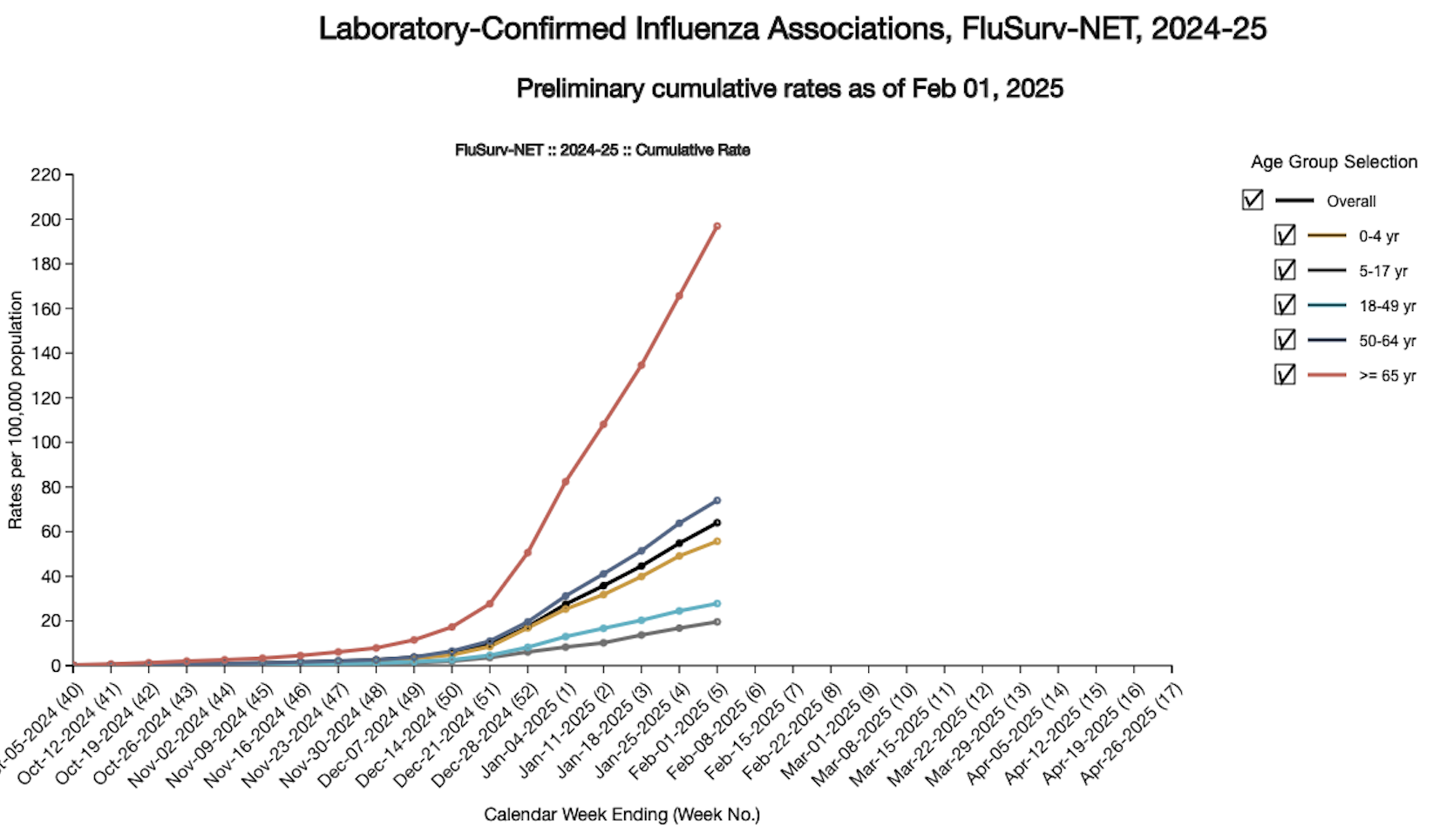The Flu-Fighting Benefits of Regular Exercise
Read This Article on My Website
Unfortunately, the flu is rising nationwide, with most infections coming from the (A)H1 and (A)H1N1 strains.

Exercise, mainly moderate and regular aerobic activity, can protect against the flu by reducing infection severity and enhancing the immune response to vaccination. These benefits are especially significant in older adults and those who maintain consistent physical activity. However, excessive exercise should be avoided during active infections. We can see below that the elderly above age 65 have a much higher rate of hospitalization compared to those in younger categories.

Moderate physical aerobic activity occurs when your heart rate increases, you feel warmer, and you can talk but not sing. Activities like brisk walking, rucking, swimming, rowing, or cycling can raise your heart rate quickly. If you have a heart rate monitor like the PolarPro, you can visualize this as being in the heart rate Zone 3, which is 70-80% of your max heart rate.
Heart Rate Max = 220 - Age
If you are 47, like me, your max heart rate is 173 beats per minute (bpm). Moderate exercise is between 121 and 138 bpm. A superior method would be to measure your lactate levels with a point-of-care meter; however, this would require drawing a small amount of blood each time. Once you understand how to achieve a moderate heart rate, you can vary the exercises to prevent boredom. My current regimen is:
- Monday: rowing
- Tuesday: off
- Wednesday: biking
- Thursday: sprints
- Friday: stair-stepper
- Saturday: off
- Sunday: running
Immune Response to Exercise
The production of antibodies increases with exercise, including natural killer cells that fight cancer, so individuals with cancer should be encouraged to find a light to moderate activity protocol they prefer. Many studies have shown that chronic exercise also protects against the possibility of infection and reduces the time it takes to return to feeling normal.
One conundrum is asking people to quarantine, yet knowing that moderate aerobic exercise, like running outside, would help prevent infection and reduce symptom severity. A possible solution would be building a home gym with dumbbells, a bench, and a treadmill. Due to the ease of access, which helps decrease mental resistance to exercise, I recommend creating one for all my patients. Physical activity increases muscle mass, decreases adiposity, and reduces chronic inflammation by lowering acute inflammatory cytokines like IL-6 and TNF-alpha.
Reducing Length of Infection and Symptoms
Overall, moderate exercise enhances immune function, reducing flu infection severity and potentially duration. However, the evidence is not definitive, and more robust studies are needed to confirm these effects in humans. One way to try and judge this for yourself is to use the Wisconsin Upper Respiratory Symptom Survey (WURSS-44). Fill out the scale every morning you are sick, and then one day, try 30 minutes of light-to-moderate exercise and fill out the survey again after you are done working out. I did this with a common cold to see how I felt, and I had some improvement in certain areas enough to convince me that exercise might be beneficial on day 6 and up of recovery. Typically, days 3 and 4 are the worst, and when patients call me. I would recommend against exercising before day 5 of a current infection. You should discuss this with your current doctor.
Wisconsin Upper Respiratory Symptom Survey (WURSS-44)

Vaccine Response Improvement with Exercise
Given that the flu vaccine only has 30-60% effectiveness(3), an adjuvant that increases this would be very useful. A vaccine aims to trigger a reaction from the immune system to produce antibodies to the flu virus. For 2025, the flu shot contains A and B strains: H1N1, H3N2, and B/Victoria strains. The A strain can potentially cause a pandemic, whereas B typically does not. Live (weakened), non-live, egg, and egg-free versions exist. You can find specific additional ingredients on package inserts.
A Meta-Analysis of 9 studies with 550 participants showed clinical measures of H1 flu strain antibody response tended to be higher in the acute-exercised participants compared to rested controls and physically active compared to inactive (1).
The primary outcomes were the effect of acute exercise (single bout of <60 min) and of physical activity on influenza vaccination immunogenicity (i.e., seroconversion, seroprotection, and antibody titer response) at 4–6 weeks. The secondary outcome was the interaction effect on immunogenicity. Outcomes effects were measured as odds ratios. The acute exercise group comprised 15–50 minutes of resistance (n = 359; studies 1, 2, 3, 5, 6, and 7 [16, 19, 21, 22, 24, 25]) or aerobic exercise (n = 20; study 4 [23]). Both cardio and resistance training increased H1 seroconversion.
Physical activity significantly increased H1 strain seroconversion (adjusted odds ratio (aOR) 1.69, 95%CI: 1.02–2.82) among all participants and titer response (aOR 1.20, 95%CI: 1.03–1.39) among the acute exercise group. Limitations include the small sample size and the fact that specific types of exercise were not discussed.
Key Point: Exercising the same arm that received the shot provided a more significant response.
Other factors, such as age, strain match, previous vaccination status, poor sleep, social isolation, and stress, can significantly reduce one's immune system. Journaling, which I discuss here, can help reduce everyday stress.
Overall Recommendations
In general, 30 minutes of resistance training three times a week in a push-pull-legs regimen and 30 minutes of cardio-focused training twice a week is a good starting point. This will help prevent flu infection and boost your vaccine response. Exercising with a current flu infection may be beneficial on days 6 and up. Of course, you should always maintain good hydration with plenty of fluids and high-quality whole-food nutrition.
Disclaimer: This newsletter is for general informational purposes only and does not constitute the practice of medicine, nursing, or other professional health care services, including the giving of medical advice, and no doctor/patient relationship is formed. The use of information in this newsletter or materials linked from this newsletter is at the user’s own risk. The content of this newsletter is not intended to be a substitute for professional medical advice, diagnosis, or treatment. Users should not disregard or delay in obtaining medical advice for any medical condition they may have and should seek the assistance of their healthcare professionals for any such conditions.
References
- Bohn-Goldbaum, E., Owen, K., Lee, V., Booy, R., & Edwards, K. (2022). Physical activity and acute exercise benefit influenza vaccination response: A systematic review with individual participant data meta-analysis. PLoS ONE, 17. https://doi.org/10.1371/journal.pone.0268625.
- https://www.cdc.gov/fluview/overview/fluview-interactive.html
-
European Centre for Disease Prevention and Control. Influenza Vaccine Effectiveness. European Center for Prevention and Control 2019.
- Fiuza-Luces, C., Valenzuela, P.L., Gálvez, B.G. et al. The effect of physical exercise on anticancer immunity. Nat Rev Immunol 24, 282–293 (2024). https://doi.org/10.1038/s41577-023-00943-0
- Ballesio, A., Zagaria, A., Violani, C., & Lombardo, C. (2023). Psychosocial and behavioral predictors of immune response to influenza vaccination: a systematic review and meta-analysis. Health Psychology Review, 18, 255 - 284. https://doi.org/10.1080/17437199.2023.2208652.


